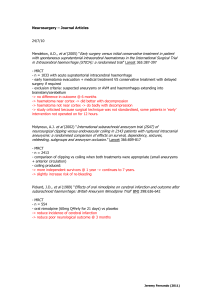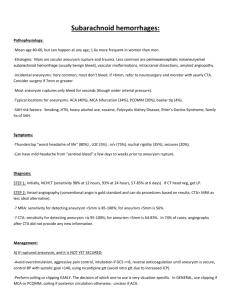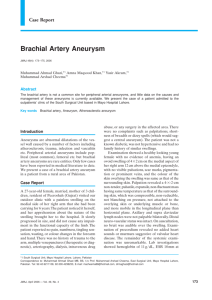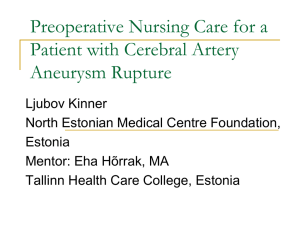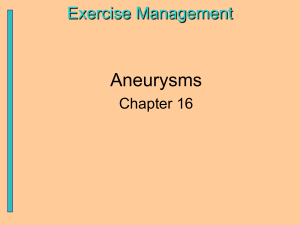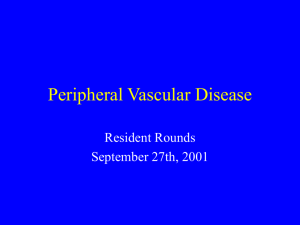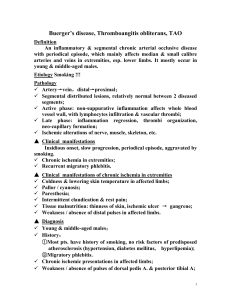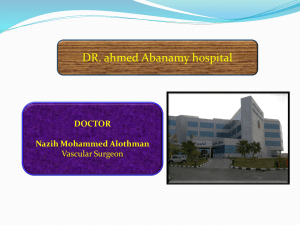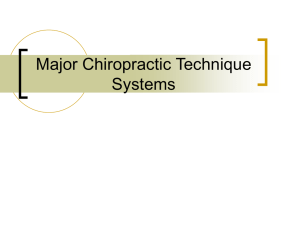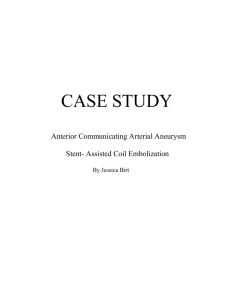(A rare case of) Segmental Medial Arteriolysis
advertisement
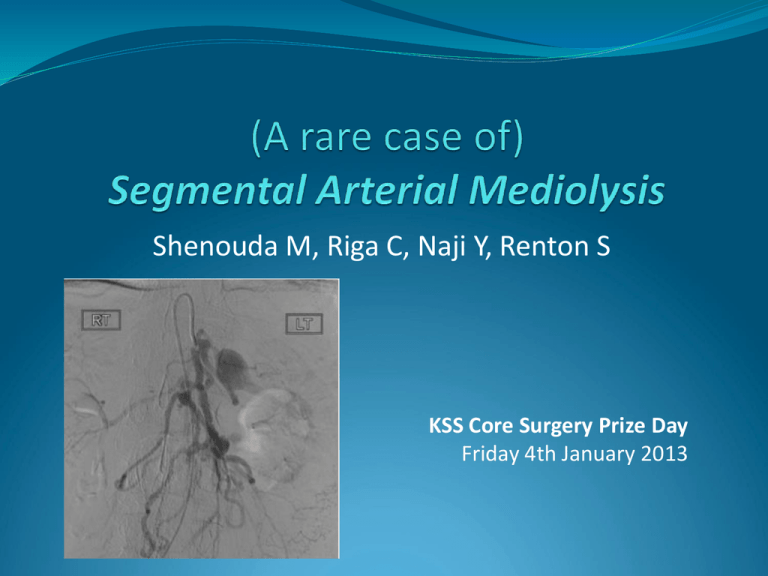
Shenouda M, Riga C, Naji Y, Renton S KSS Core Surgery Prize Day Friday 4th January 2013 Mrs X, 85 y/o PC – acute onset epigastric pain Sharp, associated with nausea, vomiting, sweating. No haematemesis/melaena; no neck/chest pain No previous episodes PMHx – 2 previous visceral aneurysm repairs (15y previously), HTN, recent NSTEMI FHx – IHD SHx – lives alone, independent, active, ex-smoker (50pack years – stopped 6/12 previously) O/E Alert, orientated, GCS 15/15 Stable vital signs: Temp 35.8, HR 52, BP 132/53, RR 18, SaO2 96% O/A Pale, clammy, otherwise normal CVS/resp ex Abdo: midline scar; severe epigastric/central tenderness with guarding. No pulsatile masses, absent bowel sounds Peripheral vasc: No signs of acute ischaemia All pulses present No radio-radial or radio-femoral delay CRT <2 sec in all four limbs Neurology intact Basic Ix Urine NAD, ECG - SR Bloods – Hb 9.2, WCC 16.2, Plt 183, Clot NAD, CRP <5 Cr 81, Ur 7.4, Na 141, K 4.7, Trop 0.13 Clotting, LFTs NAD Urgent CT Angio…. CTA 11 mm aneurysm arising from a branch of the gastroduodenal artery is seen with surrounding haematoma, suspicious for rupture. Difficult anatomy is seen with common trunk for the celiac and SMA, and a 10mm aneurysm in SMA trunk. Multiple other aneurysms – 25mm splenic artery aneurysm, 14mm aneurysm at the origin of the IMA. Management Cross-matched 6 units, fluid resuscitation Urgent angiogram… Angiogram & Embolisation LA, R CFA puncture Selective catheterisation of the celiac axis and then GDA cannulated. The aneurysm was identified. Embolisation with several microcoils proximal and distal to the aneurysm in the GDA; complete cessation of flow within the aneurysm. Findings in keeping with CTA – multiple visceral aneurysms. Also noted multiple narrowings and irregularities in the visceral arteries. SEGMENTAL ARTERIAL MEDIOLYSIS SEGMENTAL ARTERIAL MEDIOLYSIS 1976 – Slavin RE, Gonzalez-Vitale JC. Segmental mediolytic arteritis. A clinical pathologic study. Lab Interv 1976;35:23– 91. Described 3 autopsy cases partial or total mediolysis arterial gaps dissecting aneurysms rupture massive haemorrhage 85 cases in literature Abdominal visceral arteries, intracranial arteries Aetiology unknown SEGMENTAL ARTERIAL MEDIOLYSIS Presentation – intra-abdominal/intracranial haemorrhage asymptomatic on routine investigations post-mortem Diagnosis – radiological – arterial dilatation, single/multiple aneurysms, stenoses/occlusion, dissection histological – surgical resection, post-mortem SEGMENTAL ARTERIAL MEDIOLYSIS Literature review, 1976-2012 62 studies, 85 cases 69% confirmed histologically (24% on autopsy) M:F – 1.5:1 Age range 0-91 (median 57) 21% had history of hypertension 13% mortality before further investigation/management Overall mortality 25% Management – open vs endovascular Summary SAM is a rare diagnosis of unknown aetiology May be asymptomatic or present with massive haemorrhage Treatment usually restricted to symptomatic cases Endovascular embolisation can prevent the need for major surgery Can also be a temporary measure before definite surgery at a later stage References Slavin, RE. Gonzalez-Vitale, JC. Segmental mediolytic arteritis: a clinical pathologic study. Lab Invest 1976; 35:23–29. Michael, M. Widmer, U. Wildermuth, et al. Segmental arterial mediolysis: CTA findings at presentation and follow-up. AJR Am J Roentgenol 2006; 187:1463-9 Tameo, MN. Dougherty, MJ. Calligaro, KD. Spontaneous dissection with rupture of the superior mesenteric artery from segmental arterial mediolysis. J Vasc Surg 2011;53:1107-12.


